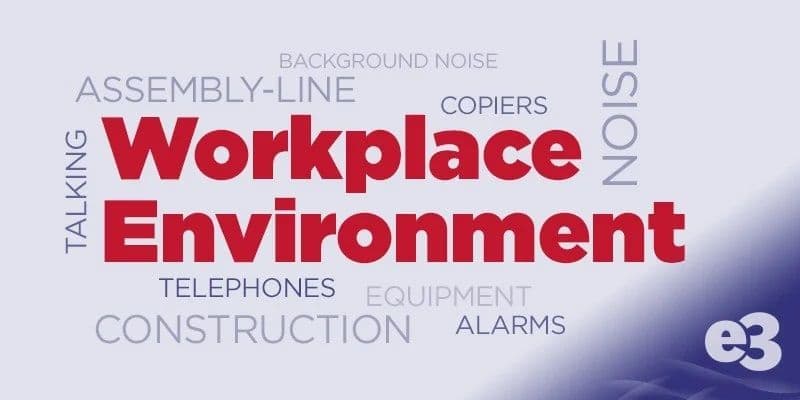Creating a Positive Workplace for Hard-of-Hearing Employees

Those who haven’t lived it can only imagine how difficult work must be for someone with severe hearing impairment. Whether you’re sitting in a desk all day, standing behind a counter, or operating heavy machinery, hearing is essential to any job.
The challenges that come with being deaf in the workplace are daunting and, in some cases, career-threatening. Discrimination against the hard of hearing is still rampant. According to the Hearing Health Foundation, untreated hearing loss can decrease one’s annual income by as much as $30,000. The organization also reported that, as of 2014, 47% of the deaf community are unemployed.
Just because someone is hard of hearing, it doesn’t mean they can’t make a positive contribution to a company. In fact, some of the world’s greatest minds had hearing impairment, including Alexander Graham Bell and Thomas Edison. That’s why it is crucial for employers to work on creating positive workplaces for people with hearing difficulties.
Change is challenging, but not impossible
Creating a positive environment for employees with hearing loss presents a series of challenges, but they aren’t insurmountable. In fact, the Americans with Disabilities Act (ADA), one of several federally mandated laws that prohibit discrimination against individuals with disabilities, has created a set of guidelines for employers to follow.
In simple language, the ADA, Title 1, requires all employers to provide reasonable accommodations to the known disability of a qualified employee or job applicant, unless this type of accommodation would impose an undue hardship on the employer. Fortunately, providing reasonable accommodations for hard-of-hearing employees isn’t as difficult as you may think. And with the progression of hearing aid technologies and increased adoption of tools like instant messaging, accommodating hearing impaired workers is less difficult than ever.
What needs to be done to accommodate a hearing disability at work
Making the workplace optimized for someone with hearing loss is the responsibility of an employer. However, if the employer isn’t aware of an employee’s hearing impairment, nothing will be done. That’s why it’s important for hearing-impaired workers to discuss their deafness and what can be done to accommodate it with their employer.
There are plenty of technologies out there that help the hard of hearing in the workplace. For starters, there are now more ways to silently communicate than there have ever been. There’s email, instant messaging, collaboration software, and many other technologies that allow us to quickly communicate through the written word. Employers need to be cognizant of this when working with hearing-impaired employees. They should have a discussion with them to determine if they would prefer being communicated this way as opposed to in person or over the phone.
What if speaking on the phone is an essential function of the job? An employer can accommodate the hearing impaired employee with a device that has volume control features. Better yet, they can set them up with a phone that displays captions of what is being said. They are relatively inexpensive and easy to use. Acquiring them can be a bit of a hassle due to FCC regulations, but it’s well worth it considering how much they can help employees with hearing difficulties.
There are also ways to rearrange an employee’s seating arrangement to minimize background noise. An employer has the power to move them to a space farther away from loud office devices, a typical gathering place for employees, or any other noisy area that can add to hearing difficulties. If they have the space, they can even set them up their own office so they drown out any distracting sounds by simply shutting their door.
Let’s not forget about those jobs that aren’t in office environments. There are plenty of ways to accommodate the hard of hearing in roles that include manual work, like operating large vehicles or heavy machinery. It can start with implementing a training process specifically for deaf employees. Then it can evolve into outfitting the workplace with visual modifications, such as mirrors and flashing lights, which will allow employees to rely more heavily on their eyes instead of their ears. Lastly, a buddy system could be put in place to ensure there are non-disabled employees looking out for those whom are hard of hearing.
A wealth of resources available
We’ve only scratched the surface of what can be done to accommodate employees with hearing difficulties. If you’re an employer looking for more information or ideas, a good place to start would be the Job Accommodation Network. It offers a vast amount of content on how you can make your work environment more suitable for the hearing impaired.
A quick Google search will also do wonders. Organizations such as the National Association of the Deaf (NAD), the U.S. Equal employment Opportunity Commission (EEOC), and the Hearing Loss Association of America (HLAA) provide guidelines and advice on this issue, all of which can easily be found online.
The time is now for you to make your workplace accommodating to those with hearing issues. Don’t let negative assumptions of the hearing impaired in the workplace cloud your judgement; there is much that can be done to ensure their success. If you don’t put the effort in to make the change now, you might miss out on the best employee you’ve ever had.
